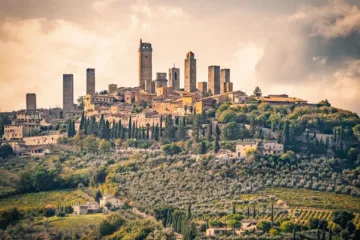
Carema is an almost alpine region, producing red wines, which is located in Piedmont (Italy), bordering the Valle d’Aosta. It is the northernmost zone of Piemonte, where the renowned Nebbiolo grape variety is grown using the Picutener and Pugnet clones. These clones are quite similar to the Lampia and Michet found in the Langhe (see Valtellina).
Carema is a small winegrowing region best recognized for its small production of traditional and great Nebbiolo-based wines known as ‘Vino di Montagna‘. Unfortunately, Carema has only been granted DOC designation, most likely due to a combination of factors: a small area, a difficult location for viticulture (meaning most producers cannot make it their primary business) and the shadows cast by surrounding Nebbiolo-based appellations. However, this location obviously has the capacity to produce outstanding wines.
Carema’s location
The Carema DOC is located in the Dora Baltea Valley in the little town of Carema, in the northernmost section of the Canavese area, close on the border with Valle d’Aosta. (See Canavese for more information)
The Alpine landscape and small strip of terraced vineyards contribute to the area’s mild climate.
About Carema vineyards
Viticulture in this very mountainous terrain is difficult, and terraces together with Pergolas (‘Tendone’) have been used to be able to grow grapes in these steep hillsides.
The majority of the vineyards are planted on terraces cut into the rocky and precipitous slopes of Mount Maletto’s foothills. They face southwest at an altitude of 300 to 700 meters.
The topsoil is made up of glacial deposits on top of metamorphic schist.
Originally, there was no suitable ground for grapes on these slopes. This problem was solved by building terraces supported by dry stone retaining walls and backfilling with soil brought up from the valley level.
Viticulture, as in many mountainous places, is exceedingly labor intensive, but this is especially true. Only a strong desire for wine and tradition keeps viticulture alive.

Carema traditional vine training system

The vines are usually trained using a local pergola system known as ‘Topia‘. The vine canopy grows along horizontal chestnut arms supported by stone and mortar pillars (known as ‘Pillun‘).
The Pergola system protects the vines from the fierce winds that blow across the Dora Baltea Valley. The stony terraces absorb heat during the day and then radiate it back to the vines at night.
The Pergola system, with its white pillars atop dry stone terraces, stands boldly in this dramatic setting and adds to the area’s attraction.
Carema winemaking requirements
Carema is based on Nebbiolo and the DOC requires a minimum of 85% of this grape variety.
The wines must be aged for at least 2 years, of which one must be spent under wood.
The Carema Riserva wines must be aged for three years, with at least one year under wood.
How does Carema compare to other Nebbiolo wines
Carema wine has a distinct character compared to other Nebbiolo wines. It generally shows more acidity and less body than the best wines of the Langhe or Gattinara. However, Carema wines are fascinating, fragrant, and enjoyable wines especially when produced in hot years.
The overall potential vineyard area is rather limited, with only 14 hectares of vines being farmed by approximately 40 grape growers. It is to benoted that viticulture is merely a side activity for the majority of them.
The resulting wines had previously been of varied quality, but mastery of malolactic fermentation has resulted in better and more consistent wines from the local cooperative winery.
The wines are usually distinguished by their sweet and delicate bouquet of roses and violets, strong acidity, and pronounced mineral character. The delicate scent balances the light body and slender structure.
The Challenges of Carema
The extensive maturing periods enforced by DOC standards, which keep the wine off the market much after competing Langhe wines, have plainly been a commercial disadvantage.
Vintage variation and weather conditions are quite important in Carema. In cooler or less productive years, Nebbiolo fails to achieve an adequate degree of maturity, and the amount of wine produced drops from modest to very small. In such vintages, the excessive acidity, along with the already light structure, causes problems. The warmest vintages yield the greatest wines, with a better balanced structure and extended aging potential.

My favorite Carema producer: Luigi Ferrando
Luigi Ferrando is locally very famous and is one of my top choice in Carema when it comes to the quality of wine.
Luigi Ferrando has long been the leading producer of wines from the Canavese region where his family’s winemaking tradition goes back to 1900.
Luigi’s sons, Roberto and Andrea, now work with him on the estate (Roberto) and in the family’s vinoteca (Andrea) located in the heart of the city of Ivrea.
The Ferrandos painstakingly cultivate their Nebbiolo vineyards on the mountainside terroir of Carema, in an amphitheater that sits in the very shadows of Monte Bianco.
It is interesting to note that their wines were the very first wines we imported to the United States back in January 1980.
Luigi Ferrando’s Carema DOC ‘Etichetta Bianca’ is very refined showing notes of spicy, red fruits, dark fruits and roses on the nose and palate.

Follow me on my Social Media
Wine is a gourmet treasure, do not abuse alcohol!
None of this content has been sponsored
I did not receive any gifts or free samples that could be related to this article


